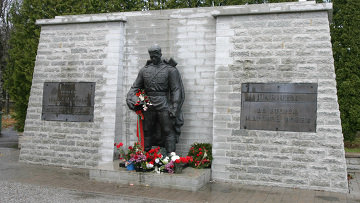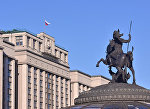STRASBOURG, March 28 – RAPSI, Ingrid Burke. The European Court of Human Rights (ECHR) held Thursday that Estonia violated its obligations under the European Convention of Human Rights (Convention) in connection with arrests and detentions that followed April 2007 riots over the relocation of a World War II monument celebrating the Red Army.
On September 22, 1944, the Red Army wrested control of Tallinn from the Nazi war machine. Three years later, a monument presently referred to as the Bronze Soldier, but originally named the “Monument to the Liberators of Tallinn” was unveiled in the city. It was built above a burial site where Soviet soldiers had been laid to rest. The monument, pictured above, featured of a bronze-cast Red Army soldier set against a plain stone backdrop.
In 2004, a growing number of local residents began to vocally demand the statue’s removal. From 2006 onward, clashes began to occur with increasing frequency between groups advocating for and against the statue’s presence.
In 2007, the Estonian parliament enacted a law providing for the exhumation and reburial of remains buried in inappropriately located grave sites. The law further provided for the relocation of war monuments.
In April of that year, Estonian police cordoned off the area surrounding the monument in preparation for the exhumation process.
The following evening, crowds of angry protesters chanting such slogans as “shame!” and “fascists!” closed in on the sight. Some members of the crowd attempted to break through police barricades.
The scene rapidly escalated into violence. Protesters threw rocks and empty bottles, and then took to looting nearby shops. Police shot rubber bullets into the crowd.
A large number of arrests were made that night.
The following morning, Estonian authorities had the monument relocated to a military cemetery. Protesters returned en masse, and still more arrests were made that evening. According to official estimates, 1,160 individuals were arrested during the course of these events. By the following month, local authorities had launched 65 criminal cases against approximately 300 people over the riots.
Seven Estonian residents – including two with Russian citizenship – who were among those arrested and detained, filed the present claim against the ECHR in 2008. The applicants include Estonian nationals Aleksandr Korobov (b. 1959), Sergei Kovaljov (b. 1992), and Gennadi Mihhaidarov (b. 1983); Russian nationals Rostislav Makariev (b. 1985) and Dmitry Tarasov (b. 1981); and two men of undetermined citizenship, Sergei Petrov (b. 1977) and Valeri Zatvornitski (b. 1970).
All seven complained that their deprivation of liberty was unlawful and arbitrary, in violation of Article 5 of the Convention.
The applicants contended that their arrests were unjustifiable as they were mere passers-by, not active rioters or looters. They further claimed to have exhausted their domestic remedies.
The court found that the applicants had not in fact exhausted their remedies, and declared the connected claims inadmissible.
The court concluded that Estonian authorities violated the rights of Petrov to protection from ill-treatment, but had not done so in the cases of Korobov, Mihhaidarov, and Zatvornitski.
Korobov, Mihhaidarov, Petrov, and Zatvornitski complained that they had suffered ill-treatment as well, in violation of Article 3 of the Convention, which states: “No one shall be subjected to torture or to inhuman or degrading treatment or punishment.”
Korobov and Zatvornitski claimed that they were beaten while in detention. Mihhaidarov claimed that he sustained a head injury after having been beaten by police with truncheons.
Petrov claimed that he sustained a fractured arm while covering his head as police beat him with truncheons. Despite complaining of pain, he was refused medical treatment and was not released from detention until the following morning.
They alleged that their claims were dismissed without an investigation by Estonian authorities.
The ECHR noted that these allegation were disputable, but that the applicants had produced sufficient evidence to support their allegations that their injuries had been caused by police force.
Considering the chaotic nature of the situation, the ECHR was unable to conclude in all but Petrov’s case that excessive force had been used: “On the basis of the above considerations, the Court concludes that the force used in respect of [Petrov] by the law-enforcement officers was excessive. At the same time, the Court finds that no such conclusion can be made in respect of [Korobov, Mihhaidarov, and Zatvornitski.]”
The Court did concluded, however, that national authorities had failed to adequately investigate all four claims. Thus they had all suffered a procedural violation of Article 3, though only Petrov suffered a substantive violation.
Ultimately the ECHR ordered Estonia to pay up €50,000: €11,000 to Korobov, Mihhaidarov, and Zatvornitski for the procedural violation of Article 3; €14,000 to Petrov for the procedural and substantive violations of the article; and €3,000 to all four jointly for legal fees.



